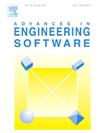A stochastic linear neural network-based differential evolution algorithm for optimizing reluctance actuator
IF 5.7
2区 工程技术
Q2 COMPUTER SCIENCE, INTERDISCIPLINARY APPLICATIONS
引用次数: 0
Abstract
Reluctance actuators encounter significant challenges in active gravity compensation due to nonlinear effects including dynamic stiffness, leakage flux, and fringing flux, which cause unstable thrust output during operation. This study focuses on suppressing thrust fluctuations in open-loop reluctance actuator gravity compensation systems through design parameter optimization. We first establish a parametric optimization model based on equivalent magnetic circuit principles to characterize nonlinear thrust dynamics. To address limitations in conventional optimization approaches, we develop a differential evolution algorithm enhanced by a stochastic linear neural network (DE-SLNN). This hybrid method combines conventional linear neural networks (CLNN) with a stochastic dynamic opposite learning mechanism (SDOLM) to strengthen DE’s search capability. Comprehensive validation using CEC 2014 benchmark confirms DE-SLNN’s accelerated convergence speed and superior search performance. Application to reluctance actuator optimization demonstrates DE-SLNN’s ability to maintain full-stroke thrust output with a small deviation of less than 2.69% for stable gravity compensation, as confirmed by thrust distribution analysis. Comparative validation with finite element analysis (FEA) reveals thrust error control within 0.16%, verifying the optimization model’s precision. Experimental results demonstrate the framework’s effectiveness in mitigating nonlinearities and achieving stable thrust output within the actuator’s operational stroke.
基于随机线性神经网络的磁阻执行器优化差分进化算法
由于动刚度、泄漏磁通和边缘磁通等非线性影响,磁阻执行器在运行过程中推力输出不稳定,因此在主动重力补偿中遇到了很大的挑战。通过设计参数优化,研究了开环磁阻作动器重力补偿系统中推力波动的抑制问题。首先建立了基于等效磁路原理的参数优化模型来表征非线性推力动力学。为了解决传统优化方法的局限性,我们开发了一种由随机线性神经网络(DE-SLNN)增强的微分进化算法。该方法将传统线性神经网络(CLNN)与随机动态反向学习机制(SDOLM)相结合,增强了神经网络的搜索能力。使用CEC 2014基准的综合验证证实了DE-SLNN的加速收敛速度和优越的搜索性能。在磁阻执行器优化中的应用表明,DE-SLNN能够保持全行程推力输出偏差小于2.69%,实现稳定的重力补偿,推力分布分析证实了这一点。与有限元分析(FEA)对比验证表明,推力误差控制在0.16%以内,验证了优化模型的精度。实验结果表明,该框架在减轻非线性和实现执行器工作行程内稳定的推力输出方面是有效的。
本文章由计算机程序翻译,如有差异,请以英文原文为准。
求助全文
约1分钟内获得全文
求助全文
来源期刊

Advances in Engineering Software
工程技术-计算机:跨学科应用
CiteScore
7.70
自引率
4.20%
发文量
169
审稿时长
37 days
期刊介绍:
The objective of this journal is to communicate recent and projected advances in computer-based engineering techniques. The fields covered include mechanical, aerospace, civil and environmental engineering, with an emphasis on research and development leading to practical problem-solving.
The scope of the journal includes:
• Innovative computational strategies and numerical algorithms for large-scale engineering problems
• Analysis and simulation techniques and systems
• Model and mesh generation
• Control of the accuracy, stability and efficiency of computational process
• Exploitation of new computing environments (eg distributed hetergeneous and collaborative computing)
• Advanced visualization techniques, virtual environments and prototyping
• Applications of AI, knowledge-based systems, computational intelligence, including fuzzy logic, neural networks and evolutionary computations
• Application of object-oriented technology to engineering problems
• Intelligent human computer interfaces
• Design automation, multidisciplinary design and optimization
• CAD, CAE and integrated process and product development systems
• Quality and reliability.
 求助内容:
求助内容: 应助结果提醒方式:
应助结果提醒方式:


